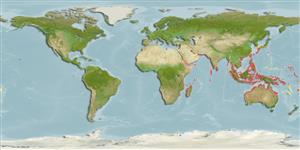Common names from other countries
Issue
Mugil amarulus Valenciennes, 1936, Mugil kelaartii Günther, 1861, and Mugil longimanus Günther, 1861 are synonyms of Moolgarda perusii (Valenciennes, 1836) according to Eschmeyer (CofF ver Jan. 2013: Ref. 92887).
Environment: milieu / climate zone / depth range / distribution range
Ecologia
marinhas; Água doce; estuarina demersal; catádromo (Ref. 26213); intervalo de profundidade 0 - 3 m (Ref. 86942). Tropical
Indo-West Pacific (Ref. 4393), including African east coast river estuaries as far south as Algoa Bay, South Africa (Ref. 52193). Recorded as far inland as Zimbabwe on the Save River (Ref. 52193).
Comprimento de primeira maturação / Tamanho / Peso / Idade
Maturity: Lm 15.1 range ? - ? cm
Max length : 41.0 cm SL macho/indeterminado; (Ref. 52193); common length : 25.0 cm TL macho/indeterminado; (Ref. 30573)
Espinhos dorsais (total) : 4 - 5; Raios dorsais (total) : 9 - 10; Espinhos anais: 2 - 3; Raios anais : 9.
Occur in shallow coastal waters, including estuaries and backwaters, frequently enters freshwater. Form larger aggregations during spawning which takes place at sea. Young individuals enter tidal rivers. Feed on organic matter contained in sand and mud (Ref. 30573). Oviparous, eggs are pelagic and non-adhesive (Ref. 205). Marketed fresh and salted. Decays rapidly, but well liked when fresh.
Ciclo de vida ou comportamento de acasalamento
Maturities | Reprodução | Spawnings | Egg(s) | Fecundities | Larvas
Thomson, J.M., 1984. Mugilidae. In W. Fischer and G. Bianchi (eds.) FAO species identification sheets for fishery purposes. Western Indian Ocean (Fishing Area 51). volume 3. [pag. var.]. FAO, Rome. (Ref. 2830)
Status na Lista Vermelha da UICN (Ref. 130435)
CITES (Ref. 128078)
Not Evaluated
Ameaça para os humanos
Harmless
Uso pelos humanos
Pescarias: espécies comerciais; isca: usually
Ferramentas
Relatórios especiais
Baixar XML
Fontes da internet
Estimates based on models
Preferred temperature (Ref.
115969): 24.8 - 29.3, mean 28.5 (based on 2356 cells).
Índice de diversidade filogenética (Ref.
82804): PD
50 = 0.5625 [Uniqueness, from 0.5 = low to 2.0 = high].
Bayesian length-weight: a=0.01148 (0.00996 - 0.01324), b=2.94 (2.90 - 2.98), in cm Total Length, based on LWR estimates for this species (Ref.
93245).
Nível Trófico (Ref.
69278): 2.4 ±0.21 se; based on food items.
Resiliência (Ref.
120179): médio(a), tempo mínimo de duplicação da população 1,4 - 4,4 anos (K=0.3).
Fishing Vulnerability (Ref.
59153): Low to moderate vulnerability (34 of 100).
